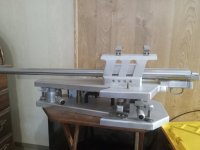Let's not worry about what has been posted as Tim can explain thar let's just keep going.
If we take a barrel blank and hang the chamber end from a string letting the muzzle point to the ground we can ring the barrel with a small wrench hammer or screwdriver and listen to it vibrate.
We can then take a finger or 2 and run it along the muzzle looking for that node we can see in both the welding rod or the fishing pole.
It will feel like nothing is vibrating while we can feel the barrel vibrating on both sides of that point.
We can mark that point with a sharpie and do the test multiple times to confirm it is there.
For the average barrel we would see in this forum that node would be roughly 2.5-3 inches back from the muzzle.
To the average shooter it would resemble a teeter tottering.
Are we still good?
I understand everything you are saying.
None of the testing provided so far can demonstrate this phenomena.


